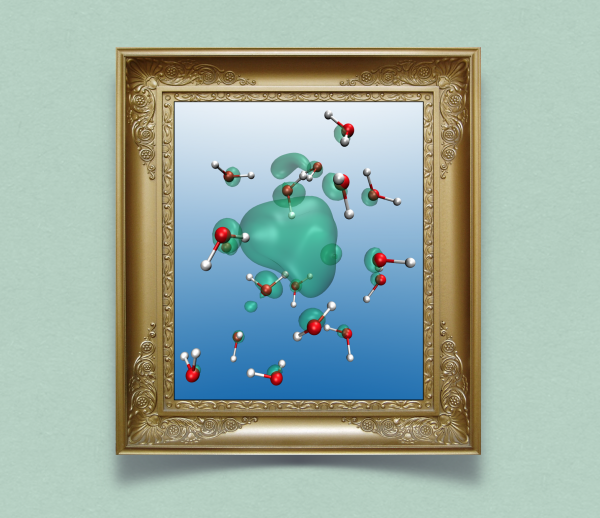Hybrid functional molecular dynamics give unprecedented view on the nature of the wet electron
by Carey Sargent, EPFL, NCCR MARVEL
The hydrated electron has been the focus of continuous and intensive experimental and theoretical research since being discovered more than fifty years ago. Researchers are fundamentally interested in understanding the response of liquid water to an excess charge, but are also by the practical implications—the species is relevant to numerous applications, including, for example, its role as a reducing agent in synthetic chemistry or in inducing mutagenic lesions in DNA. The atomistic mechanism leading to its formation and the nature of its precursors have nonetheless remained poorly understood.
Experimentally, there is widespread consensus that there are two transient precursor states that precede the formation of the hydrated electron—the quasi-free electron and the wet electron. The wet electron is a short-lived state and is thought to form when the excess electron (eaq) is trapped at defective water molecule sites, likely where broken hydrogen bonds exist, possibly due to the thermal fluctuations of the solvent. When this trapping is ineffective, eaq remains within the conduction states of the aqueous solvent and gives rise to a quasi-free electron.

Spectroscopic observations have suggested that the hydrated electron is formed in the following way: first, immediately after injection into liquid water, eaq effectively acts as a quasi-free electron. Next, it gets trapped at a broken hydrogen-bond site, which leads to the formation of the solvation shell of the equilibrated eaq. Though plausible, this mechanism remains vague and many issues need to be clarified. We need, for instance, a thorough knowledge of the energetics and atomic structure of the wet electron—we do not know to what degree the hydrogen-bond network must be perturbed to trap the excess charge.
Specifically, it would be interesting to know whether a “trap-seeking” or “trap-digging” mechanism is at play. It is not clear ether whether the wet electron steadily collapses into the hydrated electron right after trapping or whether it rather undergoes a sequence of trapping and de-trapping processes. Earlier theoretical investigations could not distinguish the quasi-free electron from the wet electron or characterize the interplay between the two.
Earlier molecular dynamics simulations carried out on bulk water systems have identified suitable trapping sites and were able to estimate their concentration and lifetime distributions. The large number of molecules involved in such calculations required the use of simplified classical interactions though and the electronic structure of the solvent was not explicitly accounted for. Researchers have also used ab initio simulations—only routinely affordable on a small number of molecules—to study the properties of the wet electron by attaching one extra negative charge to a small water cluster composed of very few molecules. This minimal model casts doubt however on the extent to which it is really representative of the more complex bulk liquid water system.
MARVEL researchers Michele Pizzochero, a PhD student at the Chair of Computational Condensed Matter Physics and lead author of this study, Francesco Ambrosio and Professor Alfredo Pasquarello at the Chair of Atomic Scale Simulation at EPFL, therefore decided to perform ab initio molecular dynamics simulations of a realistic model of bulk water. This allowed them to examine the nature of the excess electron in the early stages of the solvation process and, for the first time, to determine its energy level and accompanying structural features before thermodynamic equilibrium is established.
“Earlier theoretical work didn’t succeed in revealing the mechanism generating the hydrated electron, as they relied either on a simplified level of theory for the treatment of the solvent or a quantum mechanical description of quite unrealistic models of bulk liquid water,” Pizzochero said. “In this work, we managed to combine the best of both worlds by carrying out ab initio molecular dynamics on a realistic model of liquid water, thanks to the facilities of the Swiss National Supercomputing Center, which made it possible to run such computationally-demanding calculations.”
Their simulations support the spectroscopically suggested mechanism—that in which the initially delocalized excess electron becomes localized upon trapping in a transient state before collapsing into the hydrated electron—but also reveal the underlying dynamics.
They found that the wet electron does not decay steadily into its hydrated form, but rather undergoes repeatedly trapping and subsequent de-trapping before thermodynamic equilibrium prevails. That is, before collapse into the hydrated structure, the excess electron is found to alternate between a quasi-free state and a localized state. In the latter state, the hydrogen-bond network is severely disrupted over a large region corresponding to the extension of the electron charge density.
They identified this state as the so-called wet electron and it gives a picture that agrees with experimental observations. Overall, the findings shed new light on the elusive wet electron and offer an appealing theoretical picture to the interpretation of experimental observation
Reference: Michele Pizzochero, Francesco Ambrosio, Alfredo Pasquarello. Picture of the Wet Electron: A Localized Transient State in Liquid Water. Chemical Science 19 June 2019. DOI: 10.1039/C8SC05101A
Low-volume newsletters, targeted to the scientific and industrial communities.
Subscribe to our newsletter